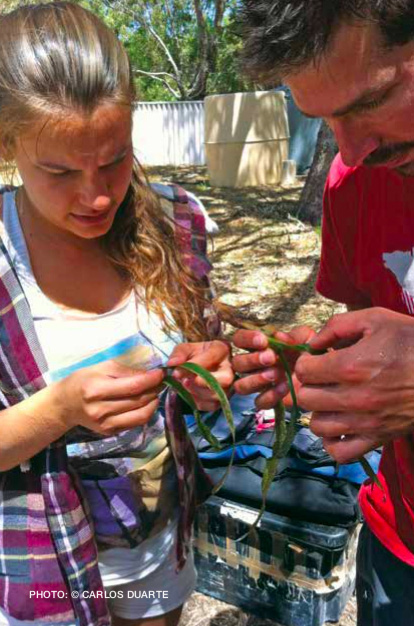Scientists at ECU and UWA have measured the amount of carbon dioxide absorbed by seagrass meadows near WA’s Rottnest Island.
They conservatively estimated that seagrass absorbs about 810 tonnes of carbon dioxide every year.
That’s a cool 22% of the island’s total annual carbon emissions.
True blue: underwater forests
ECU research collaborator Camila Bedulli, who led the study, says seagrasses are ‘true’ flowering plants.
(That sets it apart from seaweed, which is just algae with aspirations.)
She says seagrass meadows, tidal marshes and mangroves collectively make up what’s known as the ‘blue carbon’ ecosystem.
And they’re excellent carbon dioxide traps.
“They have the capacity [to store] carbon dioxide 40 times faster than terrestrial forests,” Camila says.
But this hasn’t always been well recognised. ECU marine biologist Dr Oscar Serrano says research into seagrass is about two decades behind forests on land.
“Green carbon – the conservation of terrestrial forests for climate change mitigation – has been going for 20 years,” he says.
“Blue carbon is just starting to be considered.”
“And [it’s] not included in, for instance, most national carbon accounting in Australia.”

The seagrass is always greener
Camila says seagrass is one of the world’s most valuable ecosystems, also providing food, habitat and nursery areas for fish, turtles and dugongs.
“Dugongs, for example, they rely really heavily on seagrass as their nutrition,” she says.
Seagrasses also play an important role in maintaining the soil structure.
They also protect against coastal storms by taking the energy out of waves.
“It’s a huge wave barrier,” Camila says.
At Rottnest, Camila says historical boat moorings and anchors have destroyed some of the seagrass.
She says the researchers have been working with the Rottnest Island Authority to restore these areas.
“Those mooring scars, we calculated that it was a loss of about 4.8 hectares,” Camila says.

A carbon-neutral holiday destination?
Protecting and restoring Rottnest’s seagrass could pave the way for the island to become carbon-neutral, Camila says.
“Dealing with Rottnest Island is really good,” Camila says, “because they already have in place those energy-efficiency [measures] and they don’t use cars.”

Camila hopes the research will help seagrass meadows get included in Australia’s national carbon accounting.
“This study is helping a lot to quantify how blue carbon is important and can be put into the framework,” she says.
Oscar also believes that Rottnest’s seagrass could help make the island more attractive to visitors.
“They have an opportunity to sell it as a brand,” he says.
“’Look, our waters are amazing, they have plenty of seagrass that’s supporting carbon storage, biodiversity, fisheries and so on.
“And they can actually enhance these ecosystem services by assisting [the seagrass] recovery.”








